




Knitted by Caroline




Agnisa, Atina and Poppy
We work with one of the last suppliers of Greek wool: Molokotos.
Supplier and design are located within 300 km of each other.
Therefore, a short-cycle textile project is possible.








Sweater knitted by Agnisa

-

Sweater knitted by Rita-

Caroline gives them different colorful balls of wool and a technical sketch designed with the measures and precision of the stitches.d’elle choisit le point du pull unique qu’elle va tricoter.
To be part of the dynamics, Caroline knits two sweater. That allows her to exchange with Yayas, technically as well as humanly.
A weekly meeting is set up at the café of Yayas to share the progress of each.





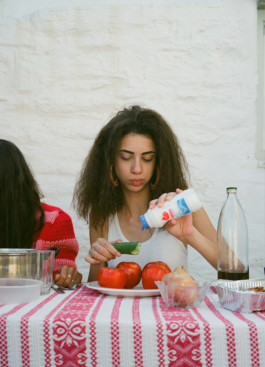






Maria’s sweater
Rita’s sweater
Caroline’s sweater
Athina’s sweater
Rosa’s sweater
Maria’s sweater
Rita’s sweater
Khaoula’s sweater
Agnisa’s sweater
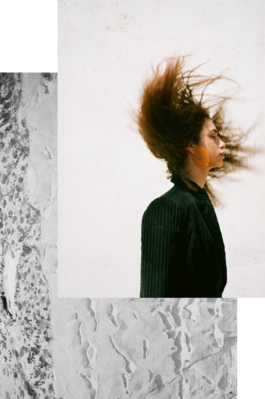
Crocheted wire earrings by Maria

Agnisa

Khaoula, Caroline & Rosa

Athina




Almost every day at the end of the day, Caroline goes at Agneza. On this balcony which overhangs the maritimes exit of the boats, she sips lemonade and eats figs from Athina's garden.
Grandmothers' days are punctuated by their religious agenda.
To make a "knit" appointment, we have to check the Church calendar.
Agneza knows everyone in Tinos: she was born on the island in 1929 and has grown in the Komi village. She then left to work in Athens as a cleaner at the Canadian embassy.
She hence speaks English. Once retired, she bought an apartment in Chora on Tinos Island and she returned to live.
She tells us that she learned to knit and to spin wool as a child.
At that time, her family had no money to buy clothes, and rarely came out of the island or their village.



Knowing the inhabitants thanks to the project allows real travels and authentic encounters. Choosing to take time for the sweater production enables her to gradually integrate to the Island's life.
Tinos is a very religious Island, the orthodox pilgrimages are very important. We attend to the procession for the Virgin icon the 23th of July. This same day, Athens burns.
The honeyed light, overcasted by the clouds of smoke gives a surrealist impression to this event.







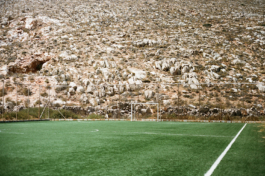






Agnisa












Agnisa
Rosa
Maria
Caroline
Rita
Agnisa
Rosa

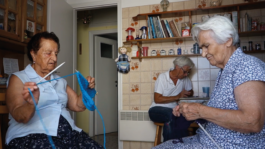



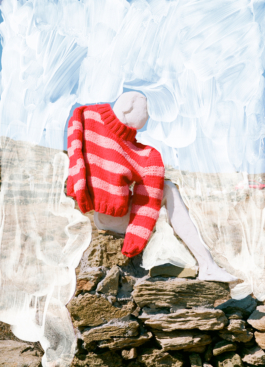
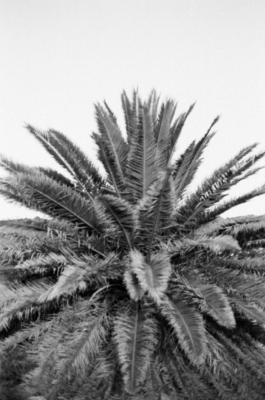





They are united on the 14th of August to present their work. They discover each other's sweaters, and try them. A lot of laughs, hugs. They are happy and proud for having participated in this project for a French brand. There are surprises, like Koula who decided to design her stripes, and also few differences considering the measures given. Litza developed her own stitch and the sweater is very nice.

-
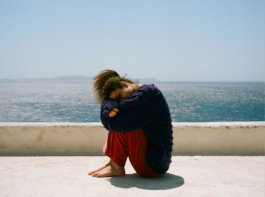


Knitted by Caroline



We work with one of the last suppliers of Greek wool: Molokotos.
Supplier and design are located within 300 km of each other.
Therefore, a short-cycle textile project is possible.

Agnisa, Atina and Poppy







Sweater knitted by Agnisa

-

Sweater knitted by Rita-

Caroline gives them different colorful balls of wool and a technical sketch designed with the measures and precision of the stitches.d’elle choisit le point du pull unique qu’elle va tricoter.
To be part of the dynamics, Caroline knits two sweater. That allows her to exchange with Yayas, technically as well as humanly.
A weekly meeting is set up at the café of Yayas to share the progress of each.












Maria’s sweater
Rita’s sweater
Caroline’s sweater
Athina’s sweater
Rosa’s sweater
Maria’s sweater
Rita’s sweater
Khaoula’s sweater
Agnisa’s sweater

Crocheted wire earrings by Maria

Agnisa

Khaoula, Caroline & Rosa

Athina

Almost every day at the end of the day, Caroline goes at Agneza. On this balcony which overhangs the maritimes exit of the boats, she sips lemonade and eats figs from Athina's garden.
Grandmothers' days are punctuated by their religious agenda.
To make a "knit" appointment, we have to check the Church calendar.

Agneza knows everyone in Tinos: she was born on the island in 1929 and has grown in the Komi village. She then left to work in Athens as a cleaner at the Canadian embassy.
She hence speaks English. Once retired, she bought an apartment in Chora on Tinos Island and she returned to live.
She tells us that she learned to knit and to spin wool as a child.
At that time, her family had no money to buy clothes, and rarely came out of the island or their village.



Knowing the inhabitants thanks to the project allows real travels and authentic encounters. Choosing to take time for the sweater production enables her to gradually integrate to the Island's life.
Tinos is a very religious Island, the orthodox pilgrimages are very important. We attend to the procession for the Virgin icon the 23th of July. This same day, Athens burns.
The honeyed light, overcasted by the clouds of smoke gives a surrealist impression to this event.














Agnisa












Agnisa
Rosa
Maria
Caroline
Rita
Agnisa
Rosa












They are united on the 14th of August to present their work. They discover each other's sweaters, and try them. A lot of laughs, hugs. They are happy and proud for having participated in this project for a French brand. There are surprises, like Koula who decided to design her stripes, and also few differences considering the measures given. Litza developed her own stitch and the sweater is very nice.

-
